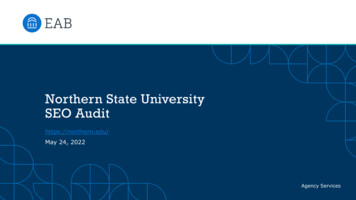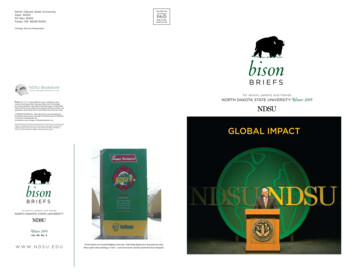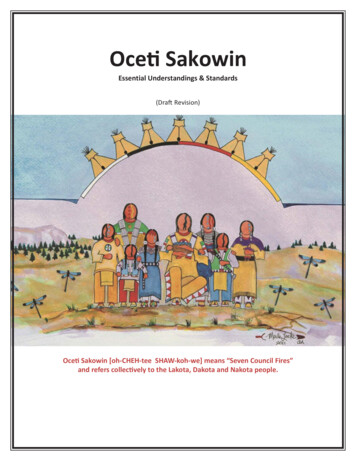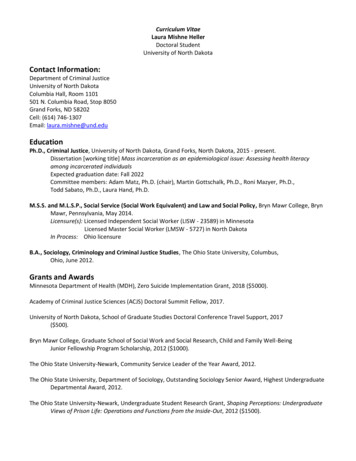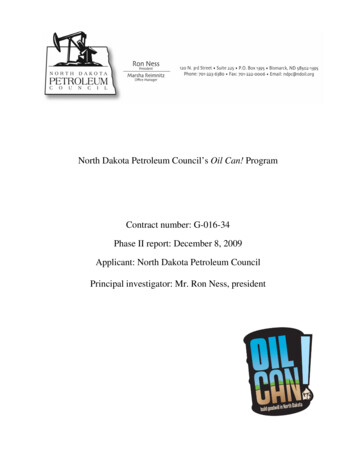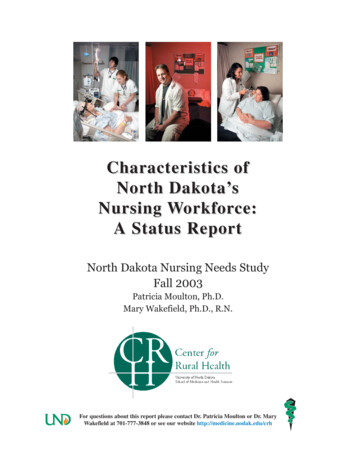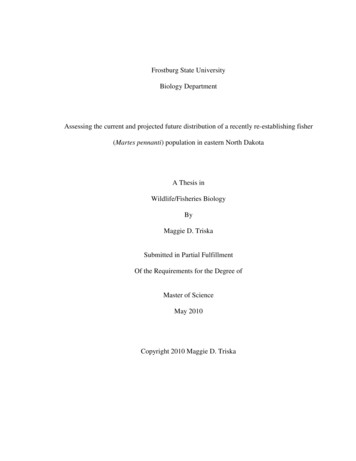
Transcription
North Dakota Marketing EducationContent StandardsApproved and Adopted September 2017North Dakota Department of Career and Technical EducationWayne Kutzer, State Director and Executive Officer600 E Boulevard Avenue, Dept. 270Bismarck, North Dakota 58505-0610
North Dakota Marketing Education Team and Standards ProcessKevin ReisenauerState Supervisor, Marketing EducationND Department of Career and Technical Education600 E. Boulevard Avenue, Department 270Bismarck, ND 58505-0610(701) 328-3182kreisena@nd.govMichael NetzloffStandards and Curriculum SpecialistND Department of Career and Technical Education600 E. Boulevard Avenue, Department 270Bismarck, ND 58505-0610(701) 328-3187mnetzloff@nd.govThis set of standards was approved and edited by the following Marketing teachers:Amber Aberle, Valley City State UniversityGregory Borders, West Fargo High, West FargoKelli Sitzler Erickson, Fargo North High, FargoJanae Helvik, Sheyenne High, West FargoLisa Hoffman, Central Cass High, CasseltonJason Holland, Davies High School, FargoTroy Olson, Century High School, BismarckSara Smith, Fargo South High, FargoAdapted from Marketing Core and Business Administration Core, MBA Research, 2015.Permission to reproduce this material is granted for home, classroom, and workshop use. For all other purposes, please request permission inwriting from the North Dakota Department of Career and Technical Education.It is the policy of the North Dakota State Board for Career and Technical Education not to discriminate in its educational programs, activities, oremployment policies as required by Final Regulation implementing Title IX of the 1972 Education Amendments, Title VI of the Civil Rights Act of1964, Section 504 of the Rehabilitation Act of 1973.The Board policy does not advocate, permit, nor practice discrimination on the basis of sex, race, color, national origin, religion, age, or disability asrequired by various state and federal laws. Equal education opportunity is a priority of the North Dakota State Board for Career and TechnicalEducation.1
North Dakota State Board for Career and Technical EducationBoard MembersChairDr. Brian DuchschererCarrington Public SchoolsCarrington, NDVice ChairDebby MarshallTGU–Towner and Granville Public SchoolsTowner, NDKirsten BaeslerDepartment of Public InstructionBismarck, NDDr. Mark HagerottNorth Dakota University SystemBismarck, NDDr. Jeff LindMandan Public SchoolsMandan, NDSonia MeehlOakes Public SchoolsOakes, NDDavid RichterWilliston Public SchoolsWilliston, NDVal MoritzValley City Public SchoolsValley City, NDMichelle KommerJob Service North DakotaBismarck, ND2
Career and Technical Education Standards IntroductionMissionThe mission of the State Board for Career and Technical Education (CTE) is to work with others to provide all North Dakota citizens with the technicalskills, knowledge, and attitudes necessary for successful performance in a globally competitive workplace.VisionThe State Board for Career and Technical Education (CTE) is committed to providing career awareness, work readiness skills, occupationalpreparation, and retraining of workers throughout the state. Career and technical education will span all educational levels, providing youth withexploration opportunities and the foundation skills needed to enter the world of work while providing adults with skills needed to enter, re-enter, oradvance in the workforce.GoalNorth Dakota Career and Technical Education’s goal is to create a competitive and knowledgeable work force. This is accomplished through a varietyof educational program areas that are organized to prepare students for careers in their chosen fields, to take leadership roles, and balance their multipleroles in life. CTE programs prepare students with the knowledge and skills to make informed career choices, to integrate and apply academic concepts,to prepare for successful participation in a global society, and to engage in lifelong learning.Standards Development ProcessStandards development is a multi-phase process. Existing and/or industry standards are the basis for the North Dakota Program Standards. A team ofexpert secondary and postsecondary teachers, business and industry representatives, and the state program supervisor draft the standards document.Once the document is finalized, the State Board for Career and Technical Education approves and adopts the standards.Course Frameworks are also developed by the writing team. A framework includes a brief overview of the course content, topical units of study, andidentifies the standards recommended for inclusion within the course. The frameworks are tailored to prepare young people for the opportunities inNorth Dakota. School Districts will use the frameworks as a guide for developing curriculum that reflects local needs.3
Key Principles of Career and Technical EducationWe believe that Career Technical Education:1.Draws its curricula, standards, and organizing principles from the workplace.The workplace provides the context, objectives, and organizing constructs for instruction and assessment. The workplace also defines thestandards of performance necessary, including those required for academic, technical, and employability skills.2.Is a critical and integral component of the total educational system, offering career-oriented benefits for all students.CTE classes offer educational benefits to students pursuing careers requiring specific technical skills as well as providing a strongfoundation for those pursuing a traditional four-year (or more) degree.3.Is a critical and integral component of the workforce development system, providing the essential foundation for athriving economy.Preparation of a well-prepared, qualified workforce requires solid academics, good work ethics, and specific technical skills as well as theability to communicate, work with others, solve problems, and use information. CTE contributes directly to this preparation byproviding a curriculum tied to specific workplace requirements.4.Maintains high levels of excellence supported through identification of academic and workplace standards, measurementof performance (accountability), and high expectations for participant success.Career Technical Education is committed to continuous improvement, attention to industry certification, and the development of highlyqualified teachers.5.Is robust and flexible enough to respond to the needs of the multiple educational environments, customers, and levels ofspecialization.CTE involves a large and complex delivery system that (1) integrates career exploration, (2) provides effective tools for organizing allcurricula, (3) facilitates the teaching and use of technology, (4) is integrated into the total learning experience, (5) enhances the learning ofacademic subjects, (6) teaches broad occupational skills, (7) includes all aspects of the industry, (8) teaches how to balance family and workresponsibilities, (9) provides job-specific training, (10) is offered at multiple levels of the educational continuum, and (11) is deliveredthrough a variety of educational environments.4
Table of ContentsPublication Availability . 1State Board Members . 2Introduction to CTE Standards. 3Principles of Career and Technical Education . 4Table of Contents . 5Explanation of the Standards Documents and Competency Categories. 6Business Law . 9Communication Skills. 10Customer Relations. 11Economics . 13Emotional Intelligence . 15Entrepreneurship . 16Financial Analysis . 17Human Resource Management . 20Information Management . 21Marketing . 23Operations . 24Professional Development . 27Strategic Management . 29Channel Management. 30Marketing Information Management . 31Marketing Planning . 33Pricing . 34Product/Service Management . 35Promotion . 37Selling . 40Career Ready Practices . 435
Business and Marketing EducationThe National Business Administration Standards provide insight into what business leaders view as important to the success of employees at various levels and invarious specialties. These standards define the content for Business and Marketing Education. They inform teachers, administrators, and curriculum developersas to what should be taught. Educators, then, take the standards and determine how to deliver the content (instructional strategies) and how to design theprograms/courses. Educators also determine what program area will deliver the performance indicators; i.e., whether the content will be addressed in a businesseducation course, marketing education course, or both. These standards address software applications rather than technical IT content that is found in a separatecluster.Premises of the CurriculumThe Business Administration curriculum should: Encourage students to think critically and innovatively Stress the integration of and articulation with academics Enable students to utilize technology in the performance of business tasks Stress the importance of interpersonal skills in a diverse society Foster an understanding and appreciation of business ethics Provide a foundation for advanced study in business Foster a realistic understanding of work Utilize a variety of interactions with the business communityMarketing ClusterCareers in the Marketing Cluster create, communicate, and deliver value to customers and manage customer relationships in ways that benefit the organizationand its stakeholders.Marketing PathwaysMarketing Communications: Career opportunities that inform, remind, and/or persuade a target market of ideas, experiences, goods/services, and/or imagesMarketing Management: Careers that require broad, cross-functional knowledge of marketing and management to support strategic decision-makingMarketing Research: Careers that utilize qualitative and quantitative research methods to determine information needs, design data-collection processes, collectdata, analyze them, and present data so that they can be used to make business decisionsMerchandising: Career opportunities in retailing that focus on efficient and effective product planning, product selection, buying, licensing, and inventory controlProfessional Selling: Careers that require in-depth knowledge of the target customer such as the customer’s needs, business, competitors, and products; pre-salesactivities; sales processes and techniques; and servicing after the sale.6
Business Administration Core StandardsBusiness Law: Understands business’s responsibility to know, abide by, and enforce laws and regulations that affect business operations and transactions[Includes Career Cluster topics (e.g., Ethics and Legal Responsibilities)]Communication Skills: Understands the concepts, strategies, and systems used to obtain and convey ideas and information (Addresses Career Cluster topic:Communications)Customer Relations: Understands the techniques and strategies used to foster positive, ongoing relationships with customers [Includes Career Cluster topics(e.g., Problem Solving and Critical Thinking, Systems)]Economics: Understands the economic principles and concepts fundamental to business operations [Includes Career Cluster topics (e.g., AcademicFoundations)]Emotional Intelligence: Understands techniques, strategies, and systems used to foster self-understanding and enhance relationships with others [IncludesCareer Cluster topics (e.g., Leadership and Teamwork, Ethics and Legal Responsibilities)]Entrepreneurship: Understands the concepts, processes, and skills associated with identifying new ideas, opportunities, and methods and with creating orstarting a new project or venture [Includes Career Cluster topics (e.g., Systems)]Financial Analysis: Understands tools, strategies, and systems used to maintain, monitor, control, and plan the use of financial resources [Includes CareerCluster topics (e.g., Systems, Technical Skills)]Human Resources Management: Understands the tools, techniques, and systems that businesses use to plan, staff, lead, and organize its human resources[Includes Career Cluster topics (e.g., Leadership and Teamwork, Problem Solving and Critical Thinking, Systems)]Information Management: Understands tools, strategies, and systems needed to access, process, maintain, evaluate, and disseminate information to assistbusiness decision-making [Includes Career Cluster topics (e.g., Information Technology Applications, Technical Skills)]Marketing: Understands the tools, techniques, and systems that businesses use to create exchanges and satisfy organizational objectives [Includes Career Clustertopics (e.g., Systems)]Operations: Understands the processes and systems implemented to monitor, plan, and control the day-to-day activities required for continued businessfunctioning [Includes Career Cluster topics (e.g., Safety, Health and Environmental; Systems)]Professional Development: Understands concepts, tools, and strategies used to explore, obtain, and develop in a business career [Includes Career Cluster topics(e.g., Problem Solving and Critical Thinking, Employability and Career Development, Technical Skills)]Strategic Management: Understands tools, techniques, and systems that affect a business’s ability to plan, control, and organize an organization/department[Includes Career Cluster topics (e.g., Technical Skills)]7
Marketing StandardsInstruction for the marketing cluster is based on the 13 Business Administration Core Standards, plus seven additional standards with outcomes unique tomarketing careers: Channel ManagementMarketing-Information ManagementMarket PlanningPricingProduct/Service ManagementPromotionSellingAdditional standards address specialized content associated with selected pathways.Curriculum Planning LevelsTo facilitate curriculum planning, the performance indicators are assigned to one of six curriculum planning levels. These levels represent a continuum ofinstruction ranging from simple to complex. The levels can serve as building blocks for curriculum development in that students should know and be able toperform the performance indicators at one level before tackling more complex skills and knowledge at the next level.Curriculum planning levels can also be used as the basis for developing an unduplicated sequence of instruction for articulation between high school andpostsecondary business courses. The six curriculum planning levels are: Prerequisite (PQ)Career-Sustaining (CS)Specialist (SP)Supervisor (SU)Manager (MN)Owner (ON)8
Standard1Topic 1.1Topic 1.2BUSINESS LAWUnderstands business's responsibility to know, abide by, and enforce laws and regulations that affect businessoperations and transactionsAcquire foundational knowledge of business laws and regulations to understand their nature and scope.Student Competencies1.1.1Describe legal issues affecting businesses (BL:001) (SP)1.1.2Describe legal issues affecting the marketing of sport/event products (BL:058, BA LAP 10) (SP)1.1.3Discuss legal considerations in the finance industry (BL:133) (SP)1.1.4Discuss the effect of tax laws and regulations on financial transactions (BL:134) (SP)1.1.5Explain the nature of regulations affecting the hospitality and tourism industry (BL:065) (SP)1.1.6Describe the rights of customers in the hospitality and tourism industry (BL:135) (SP)1.1.7Explain the nature of business licenses and permits (SP)Apply knowledge of business ownership to establish and continue business operations.Student Competencies1.2.1Explain types of business ownership (BL:003, LAP-BL-001) (CS)1.2.2Select form of business ownership (BL:006, LAP-BL-002) (ON)9
Standard2Topic 2.1Topic 2.2Topic 2.3COMMUNICATION SKILLSUnderstands the concepts, strategies, and systems used to obtain and convey ideas and informationRead to acquire meaning from written material and apply verbal skills to obtain and convey information.Student Competencies2.1.1Analyze company resources to ascertain policies and procedures (CO:057) (CS)2.1.2Employ communication styles appropriate to target audience (CO:084) (CS)2.1.3Defend ideas objectively (CO:061) (CS)2.1.4Handle telephone calls in a businesslike manner (CO:114) (CS)2.1.5Participate in group discussions (CO:053) (CS)Record information to maintain and present a report of business activity.Student Competencies2.2.1Utilize note-taking strategies (CO:085) (CS)2.2.2Organize information (CO:086) (CS)2.2.3Select and use appropriate graphic aids (CO:087) (CS)Write internal and external business correspondence to convey and obtain information effectively.Student Competencies2.3.1Explain the nature of effective written communications (CO:016) (CS)2.3.2Select and utilize appropriate formats for professional writing (CO:088) (CS)2.3.3Edit and revise written work consistent with professional standards (CO:089) (CS)2.3.4Write professional e-mails (CO:090) (CS)2.3.5Write business letters (CO:133) (CS)2.3.6Write informational messages (CO:039) (CS)2.3.7Write inquiries (CO:040) (CS)2.3.8Write persuasive messages (CO:031) (SP)2.3.9Prepare simple written reports (CO:094) (SP)2.3.10Write executive summaries (CO:091) (SP)2.3.11Maintain day-to-day content on social platforms (CO:193) (SP)2.3.12Develop a crisis management plan (CO:200) (MN)10
Standard3Topic 3.1Topic 3.2Topic 3.3CUSTOMER RELATIONSUnderstands the techniques and strategies used to foster positive, ongoing relationships with customersFoster positive relationships with customers to enhance company image and sales.Student Competencies3.1.1Explain the nature of positive customer relations (CR:003, LAP-CR-001) (CS)3.1.2Demonstrate a customer-service mindset (CR:004, LAP-CR-004) (CS)3.1.3Develop rapport with customers (CR:029) (CS)3.1.4Reinforce service orientation through communication (CR:005) (CS)3.1.5Respond to customer inquiries (CR:006) (CS)3.1.6Adapt communication to the cultural and social differences among clients (CR:019) (CS)3.1.7Interpret business policies to customers/clients (CR:007) (CS)3.1.8Explain the responsibilities of finance professionals in providing client services (CR:012) (CS)3.1.9Process customer/guest orders (CS)3.1.10Identify strategies to manage customer experience during peaks in demand (CS)3.1.11Maintain service standards during peaks in demand (CS)3.1.12Identify credit-card fraud prevention methods (CS)3.1.13Explain the nature of identity theft controls (CS)3.1.14Process customer payments (FI:127) (CS)3.1.15Use social media to enhance customer post-sales experience (CR:028) (SP)Resolve conflicts with/for customers to encourage repeat business.Student Competencies3.2.1Handle difficult customers (CR:009, LAP-CR-003) (CS)3.2.2Handle customer/client complaints (CR:010, LAP-CR-010) (CS)3.2.3Describe customer service challenges in the hospitality and tourism industry (CS)3.2.4Resolve hospitality and tourism related conflicts for customers (CS)3.2.5Explain the nature of guest recovery (CS)3.2.6Determine strategies for resolving customer-service situations (SP)3.2.7Resolve sensitive/dangerous customer service situations (SP)3.2.8Resolve comprising/fraudulent customer service situations (SP)Reinforce company's image to exhibit the company's brand promise.Student Competencies3.3.1Identify company's brand promise (CR:001, LAP-CR-006) (CS)3.3.2Determine ways of reinforcing the company's image through employee performance (CR:002) (CS)3.3.3Explain the nature of customer service in the hospitality and tourism industry (CS)3.3.4Differentiate between offering services and offering products in hospitality and tourism (CS)3.3.5Identify factors affecting customer service practices in hospitality and tourism (CS)11
Topic 3.43.3.6Identify factors associated with positive customer experiences (CS)3.3.7Anticipate unspoken customer needs (CS)3.3.8Accommodate special needs/specific requests of customers (CS)3.3.9Deliver positive moments of truth (CS)Understand the nature of customer relationship management to show its contributions to a company.Student Competencies3.4.1Discuss the nature of customer relationship management (CR:016, LAP-CR-002) (SP)3.4.2Explain the role of ethics in customer relationship management (CR:017) (SP)3.4.3Describe the use of technology in customer relationship management (CR:018) (SP)12
Standard4Topic 4.1Topic 4.2Topic 4.3Topic 4.4ECONOMICSUnderstands the economic principles and concepts fundamental to business operationsUnderstand fundamental economic concepts to obtain a foundation for employment in business.Student Competencies4.1.1Explain the concept of economic resources (EC:003, LAP-EC-014) (CS)4.1.2Describe the concepts of economics and economic activities (EC:001, LAP-EC-006) (CS)4.1.3Determine economic utilities created by business activities (EC:004, LAP-EC-013) (CS)4.1.4Explain the principles of supply and demand (EC:005, LAP-EC-011) (CS)4.1.5Describe the functions of prices in markets (EC:006, LAP-EC-012) (CS)4.1.6Distinguish between economic goods and services (EC:002, LAP-EC-010) (CS)Understand the nature of business to show its contributions to society.Student Competencies4.2.1Explain the role of business in society (EC:070, LAP-EC-020) (CS)4.2.2Describe types of business activities (EC:071, LAP-EC-019) (CS)4.2.3Explain the organizational design of businesses (EC:103, LAP-EC-023) (SP)4.2.4Discuss the global environment in which businesses operate (EC:104, LAP-EC-022) (SP)4.2.5Describe factors that affect the business environment (EC:105, LAP-EC-026) (SP)4.2.6Explain the nature of business ethics (EC:106, LAP-EC-021) (SP)4.2.7Explain how organizations adapt to today's markets (EC:107, LAP-EC-025) (SP)4.2.8Explain the relationship between the economy and hospitality and tourism (EC:136) (SP)Understand economic systems to be able to recognize the environments in which businesses function.Student Competencies4.3.1Explain the types of economic systems (EC:007, LAP-EC-017) (CS)4.3.2Identify the impact of small business/entrepreneurship on market economies (EC:065) (CS)4.3.3Explain the concept of private enterprise (EC:009, LAP-EC-015) (CS)4.3.4Identify factors affecting a business's profit (EC:010, LAP-EC-002) (CS)4.3.5Determine factors affecting business risk (EC:011, LAP-EC-003) (CS)4.3.6Explain the concept of competition (EC:012, LAP-EC-008) (CS)4.3.7Describe the impact of unions on the sport/event industries (EC:053) (SP)Acquire knowledge of the impact of government on business activities to make informed economic decisions.Student Competencies4.4.1Determine the relationship between government and business (EC:008, LAP-EC-016) (CS)4.4.2Describe the nature of taxes (EC:072, LAP-EC-027) (SP)4.4.3Describe small-business opportunities in international trade (EC:066) (SP)13
Topic 4.5Topic 4.6Topic 4.7Analyze cost/profit relationships to guide business decision-making.Student Competencies4.5.1Explain the concept of productivity (EC:013, LAP-EC-018) (CS)4.5.2Analyze impact of specialization/division of labor on productivity (EC:014, LAP-EC-007) (SP)4.5.3Explain the concept of organized labor and business (EC:015, LAP-EC-005) (SP)4.5.4Explain the impact of the law of diminishing returns (EC:023) (SP)4.5.5Describe the concept of economies of scale (EC:077) (MN)Understand economic indicators to recognize economic trends and conditions.Student Competencies4.6.1Discuss the measure of consumer spending as an economic indicator (EC:081) (SP)4.6.2Explain the concept of Gross Domestic Product (GDP) (EC:017, LAP-EC-001) (SP)4.6.3Describe the economic impact of inflation on business (EC:083, LAP-EC-028) (SP)4.6.4Discuss the impact of a nation's unemployment rates (EC:082, LAP-EC-029) (SP)4.6.5Explain the economic impact of interest-rate fluctuations (EC:084) (SP)4.6.6Determine the impact of business cycles on business activities (EC:018, LAP-EC-009) (SP)Understand global trade's impact to aid business decision-making.Student Competencies4.7.1Explain the nature of global trade (EC:016, LAP-EC-004) (SP)4.7.2Describe the determinants of exchange rates and their effects on the domestic economy (EC:100, LAP-EC-030)(SP)4.7.3Discuss the impact of cultural and social environments on global trade (EC:045, LAP-EC-024) (SP)Explain international trade considerations for sport/event industries (customs, exchange rates, use of financial4.7.4institutions, trade regulations, foreign distributors, government regulation, cultural/value differences) (EC:059) (SP)14
Standard5Topic 5.1Topic 5.2EMOTIONAL INTELLIGENCEUnderstands techniques, strategies, and systems used to foster self-understanding and enhance relationships withothersApply ethics to demonstrate trustworthiness and manage stressful situations.Student Competencies5.1.1Take responsibility for decisions and actions (EI:075) (PQ)5.1.2Manage commitments in a timely manner (EI:077) (CS)5.1.3Explain the nature of stress management (EI:028, LAP-EI-025) (SP)Use communication skills to foster open, honest communications and ethical interactions, while influencing others.Student Competencies5.2.1Explain ethical considerations in providing information (EI:038) (SP)5.2.2Persuade others (EI:012) (SP)5.2.3Demonstrate negotiation skills (EI:062, LAP-EI-008) (SP)5.2.4Give elevator pitch (EI:093) (SP)5.2.5Describe personal traits important to success in hospitality and tourism management (EI:090) (PQ)5.2.6Determine and respond appropriately to personality types (EI:066) (SP)15
Standard6Topic 6.1Topic 6.2Topic 6.3ENTREPRENEURSHIPUnderstands the concepts, processes, and skills associated with identifying new ideas, opportunities, and methodsand with creating or starting a new project or ventureEmploy entrepreneurial discovery strategies to generate feasible ideas for business ventures.Student Competencies6.1.1Explain the need for entrepreneurial discovery (EN:001) (ON)6.1.2Discuss entrepreneurial discovery processes (EN:002) (ON)6.1.3Assess global trends and opportunities for business ventures (EN:003) (ON)6.1.4Determine opportunities for venture creation (EN:004) (ON)6.1.5Assess opportunities for venture creation (EN:005) (ON)6.1.6Generate venture ideas (EN:006) (ON)6.1.7Determine feasibility of venture ideas (EN:038) (ON)Develop concept for new business venture to evaluate its success potential.Student Competencies6.2.1Describe entrepreneurial planning considerations (EN:007) (ON)6.2.2Explain tools used by entrepreneurs for venture planning (EN:008) (ON)6.2.3Assess start-up requirements (EN:009) (ON)6.2.4Assess risks associated with venture (EN:010) (ON)6.2.5Assess the need to use external resources for concept development (EN:012) (ON)Determine needed resources for a new business venture to contribute to its start-up viability.Student Competencies6.3.1Explain considerations in making the decision to hire staff (EN:018) (ON)6.3.2Identify capital resources needed for the venture (EN:020) (ON)6.3.3Assess the costs/benefits associated with resources (EN:021) (ON)6.3.4Use external resources to supplement entrepreneur's expertise (EN:022) (ON)16
Standard7Topic 7.1Topic 7.2FINANCIAL ANALYSISUnderstands tools, strategies, and systems used to maintain, monitor, control, and plan the us
Wayne Kutzer, State Director and Executive Officer 600 E Boulevard Avenue, Dept. 270 Bismarck, North Dakota 58505-0610 . 1 North Dakota Marketing Education Team and Standards Process Kevin Reisenauer Michael Netzloff State Supervisor, Marketing Education Standards and Curriculum Specialist ND Department of Career and Technical Education ND Department of Career and Technical Education 600 E .

